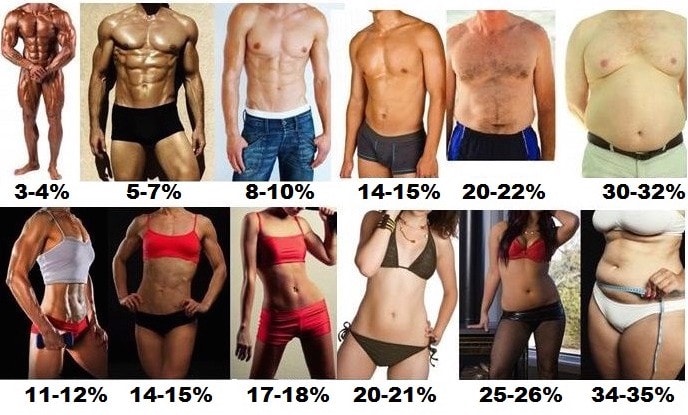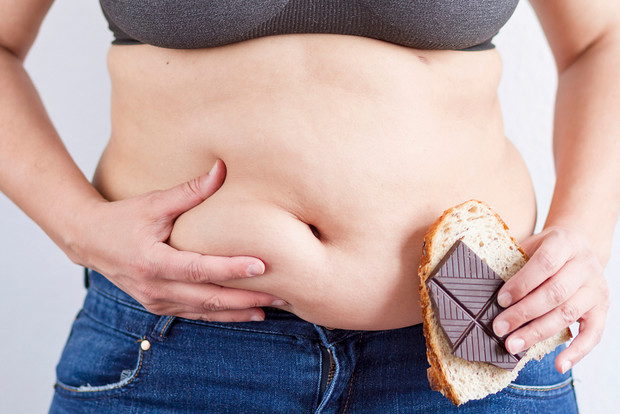Content:
- Fat percentage rates for men and women
- Percentage of body fat. illustrative example
- Methods used for measurement
- Results
- Fat, overweight and obesity
- Possible Complications Due to Excess Body Fat
Fat percentage rates for men and women:
| Women | Men | |
| Minimum required fat | 10-12% | 2-4% |
| Athletic physique | 13-20% | 5-13% |
| Toned athletic body | 21-24% | 14-17% |
| Permissible body fat percentage for an average person | 25-31% | 18-25% |
| Obesity | 32%+ | 26%+ |
Percentage of body fat. illustrative example

Methods used for measurement
US Navy Formula Result:
There are many special methods used to measure body fat. The above calculator uses a method that incorporates equations developed at the Naval Health Research Center by Hodgdon and Beckett in 1984.
Please note that the results of these calculations are approximate as they are based on many different assumptions to make them as applicable to as many people as possible. More accurate measurement of body fat requires the use of tools such as bioelectrical impedance analysis or hydrostatic density measurement.
Formula result based on BMI:
Method based on BMI (body mass index, BMI). One of the most common methods based on height and weight and age. But after the age of 30, the accuracy of this formula decreases (gives greater indicators than it actually is).
YMCA result
The method was developed by a youth volunteer organization, YMCA (YMCA, Youth Christian Association), whose branches are located in 130 countries around the world. Only weight and waist circumference are used for calculation.
Results:
Our calculator uses three formulas to calculate body fat percentage, showing the average. Thanks to this approach, you can get the most accurate result. In the results you can also see the values for each of the three methods.
Fat, overweight and obesity

The scientific term for body fat is "adipose tissue". Adipose tissue performs a number of important functions. Its main purpose is to store lipids from which the body produces energy. In addition, it releases a number of important hormones and provides the body with some cushioning as well as insulation.
Body fat includes basal fat and stored fat. Essential body fat is the base level of fat found in most parts of the body. Fat is needed to support vital activity and reproductive function. The amount of essential fat varies between men and women and is typically around 2-5% for men and 10-13% for women. The normal body fat range for men is usually 8-19% and for women it is 21-33%. While excess body fat can have many detrimental effects on an individual's health, a lack of body fat can itself have negative health effects, and keeping body fat percentage below or even within the required body fat percentage range is a topic, which should be discussed, discussed with a healthcare professional.
Stored fat is fat that accumulates in adipose tissue, whether it is subcutaneous fat (deep under the dermis and wrapped around vital organs) or visceral fat (fat located inside the abdomen, between organs), and references to body fat usually refer to this type of fat. Although some body fat is ideal, excess body fat can have serious negative health effects.
Excess body fat leads to overweight and eventually obesity, given that sufficient measures are not taken to curb the increase in body fat. Note that being overweight does not necessarily indicate excess body fat. Human body weight is made up of many factors, including (but not limited to) body fat, muscle, bone density, and water content. Thus, very muscular people are often classified as overweight.
The rate at which body fat accumulates varies from person to person and depends on many factors, including genetic factors as well as behavioral factors such as lack of exercise and excessive food intake. Due to various factors, it may be more difficult for some people to reduce fat deposits stored in the abdomen. However, diet and exercise have been shown to reduce stored fat. Please note that both women and men store fat differently and this may change over time. After age 40 (or after menopause in some cases for women), a decrease in sex hormones can lead to excess fat in the abdomen in men or around the buttocks and thighs in women.
Possible Complications Due to Excess Body Fat
The World Health Organization (WHO) classifies obesity as one of the leading preventable causes of death worldwide.
As mentioned earlier, fat produces a number of important hormones that affect the human body. Excess or lack of critical hormones can have negative consequences that interfere with the normal functioning of the body. By the way, studies have shown that excess body fat, especially in the abdomen, disrupts the normal balance and function of some of these hormones. In addition, body fat, especially visceral fat, plays a role in the release of specific cytokines, which are a broad category of proteins involved in cell signaling that can potentially increase the risk of cardiovascular disease. Visceral fat is also directly linked to higher levels of low-density lipoprotein (LDL) cholesterol, lower levels of high-density lipoprotein (HDL) cholesterol, and insulin resistance. LDL cholesterol is commonly referred to as "bad cholesterol" and HDL as "good cholesterol". High LDL cholesterol levels can clog arteries and lead to complications, including heart attacks. Insulin resistance involves cells not responding properly to the hormone insulin, which can lead to high blood sugar and eventually type 2 diabetes. As you can see, excess visceral fat can have tangible negative consequences for human health.